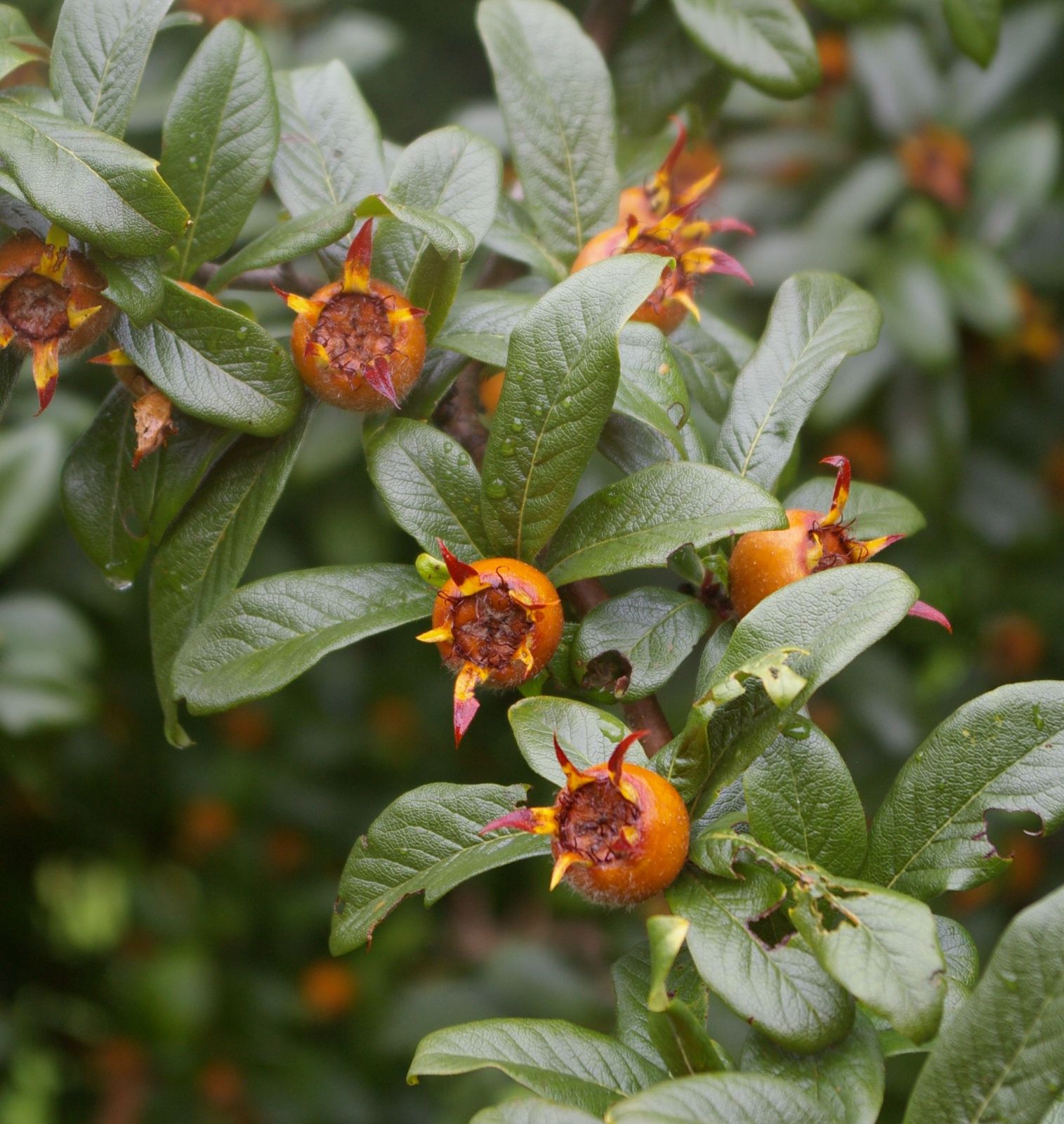Mespilus
Sponsor
Kindly sponsored by
HSH The Prince d'Arenberg

Credits
Julian Sutton (2023)
Recommended citation
Sutton. J. (2023), 'Mespilus' from the website Trees and Shrubs Online (treesandshrubsonline.
Family
- Rosaceae
Common Names
- Medlar
A single species of deciduous shrub or small tree indigenous to SW Asia, Crimea, and perhaps the southeastern Balkans, grown for both fruit and ornament, and naturalized much more widely, especially in Europe.
Mespilus belongs to a distinct group within the Rosaceae whose fruits are pomes. A pome is a type of accessory fruit (‘false fruit’) which develops from more than just the ovary (Esau 1977). The wall of the inferior ovary becomes the endocarp – the stony layer around a medlar seed or the leathery core of an apple – while most of the fleshy outer layers are derived from the hypanthium at the base of the flower (Phipps et al. 1991). These pome-bearing plants have long been recognized as a group, but under different names at various taxonomic levels, from subfamily Maloideae to sub-tribe Malinae by way of tribe Pyreae or Maleae (Robertson et al. 1991; Juniper & Mabberley 2019). Significant genera include Amelanchier, Aronia, Chaenomeles, Cotoneaster, Crataegus, Cydonia, Docynia, Malus, Photinia, Pyracantha, Pyrus, Sorbus and those other genera once lumped together in Sorbus, as well as Mespilus itself. Mespilus has long been considered close to Crataegus, and molecular studies confirm this, usually as sister genera (eg. Lo, Stefanović & Dickinson 2007; Potter et al. 2007; Li et al. 2012). In both Crataegus and Mespilus the walls of each carpel become very hard, enclosing one flake-like seed per carpel. These pyrenes are the stony, separate ‘pips’ within the flesh of the fruit. Fruits of both genera have a broad hypanthial opening, seen as a shallow pit at the ‘flower end’, although this is proportionately much broader in Mespilus. Other genera have different types of pome, for example the apple (Malus) with its leathery core formed from the ovary wall, and Amelanchier in which only the seed itself is hard (Phipps 2016).
While as a single species the Medlar is easily recognized, pinning down the distinction between Mespilus and Crataegus in botanical terms proves less easy, and various attempts have been criticised for not distinguishing Mespilus from some lesser known hawthorns (Lo, Stefanović & Dickinson 2007; Phipps 2016). There is ongoing controversy over whether they should be united as a single genus. The North American hawthorn authority James Phipps continues to champion the two-genus treatment (Phipps 2016, 2016), arguing that a morphological distinction can be made (see key below for his rather technical points), both genera are monophyletic, folk taxonomy across many cultures consistently distinguishes medlars from hawthorns, and that combining the genera would be disruptive to nomenclature. This approach remains common in the literature, is currently used by most botanic garden catalogues (eg. Royal Botanic Garden Edinburgh 2023; Missouri Botanical Garden 2023), and is accepted by the Royal Horticultural Society.
Conversely, Lo, Stefanović & Dickinson (2007) had made the case that these sister genera were sufficiently similar to be included within a single genus. Strict application of the rules of nomenclature would have resulted in all Crataegus being renamed in Mespilus, avoided only by conserving the name Crataegus over Mespilus (Talent et al. 2008). Plants of the World Online (Royal Botanic Gardens, Kew 2023) follows this approach, with M. germanica becoming C. germanica.
Linnaeus’s (1753) generic epithet is a tree name dating from Classical times, although it is not entirely certain that this was originally the medlar (Baird & Thieret 1989). For most of its history just one species has been recognized, M. germanica. The only other name sometimes seen in contemporary literature is M. canescens J.B. Phipps, the result of misinterpretation of the natural intergeneric hybrid ×Crataemespilus canescens (q.v.) when first discovered.
Identification key |


